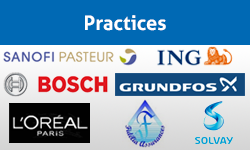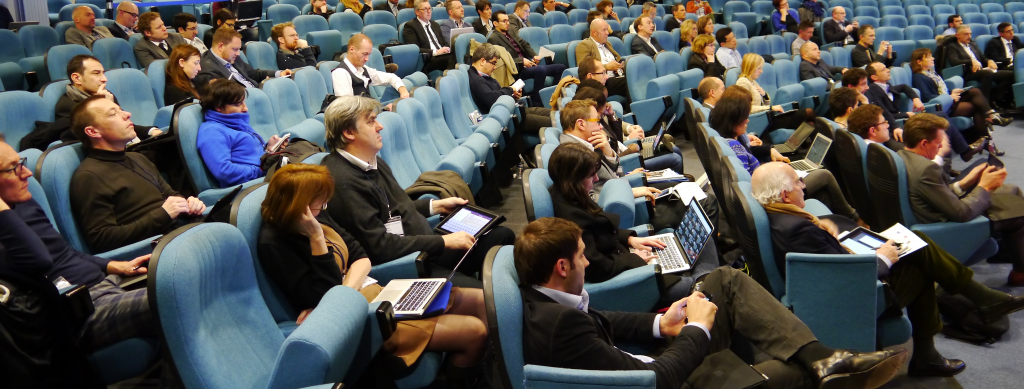 My main interest at the Enterprise 2.0 Summit this week was to get down and dirty and detailed in the case studies, as in my view (being an Engineer by training) all the theory is great, but it’s when you try and make stuff actually happen that you get a wholly different level of learning. We will write the studies up in more detail later, but here are the summary take-aways I took away:
My main interest at the Enterprise 2.0 Summit this week was to get down and dirty and detailed in the case studies, as in my view (being an Engineer by training) all the theory is great, but it’s when you try and make stuff actually happen that you get a wholly different level of learning. We will write the studies up in more detail later, but here are the summary take-aways I took away:
Marcell Tardy – Solvay Pasteur
Used Social tools to foster new culture in post merger integration. Used the 6 weeks leading up to a major all new hands convention to put out a lot of issues into the “digital” air, got all the senior managers involved in answering questions and concerns, so by the time of the all hands there had been a huge amount of discussion and debate. Some key benefits were:
– a lot of the issues were aired, some already defused
– major problems to deal with identified for focus
– process in itself built confidence and communication
Joachim Heinz Niemeyer – Bosch
Bosch see a shift from the mass production to network age and wanted to understand how it works. Initially decided to use Social technology to improve knowledge productivity:
– Wanted more innovation – patents per day
– Faster product development
– Reduce lead time of new plant design & development (got it down from 8 weeks to 8 days)
Lessons were:
– Multiple vectors of change – technology, organisation, culture, leadership, guidelines/principles
– Must infuse openness in the technology
– Onboarding wizard very critical to drive adoption
Then used it in a part of the main operations, for Capacity Requirements Planning. Found the traditional methods are fine for mass production, but not good for rapid reaction to customer service. [AP – I can echo that, which is why so may informal systems exist around the “big” CRP system].
Main benefits were:
– All the “unstructured” CRP data in one place on the social net
– Very wide dissipation of problems – ie visibility [AP – sort of like digital Andon lights – wonder what happens if there is chronic under capacity or serious shortages though, you could swamp a system]
Jean-Paul Chapon – Societe Generale
Approach was based on Pragmatism – meant using open source vs “closed solutions” – preferred open source as they had control of the system, the data and future development (key issues for Financial Service security). He made 2 major observations about the implementation:
– Intranet vs Social Media is like a machine vs a “cafe numerique” – one is sterile, the other is active and alive
– This means you have to let the adoption mature, it has a settling in period
When asked what his biggest surprise was, he said it was the power of open source software v big players
Martin Risgaard Rasmussen – Grundfos
They have used Social tools for a number of applications, but he notes that in a business dynamic you need a clear business purpose for implementing these technologies:
1. Global Talented Manager program
Used Social tools instead of flying to meetings, ran it 24/7. Moved from Lotus Notes to Outlook in 3 months, deployed staff as change agents to help it along and and used Yammer – no emails – so everyone sees answers. v 1400 people involved. 5 main lessons:
– “Not about tech” – but it is, easy access iPads etc are key
– “Not about features”, but it is -eg used translate functions in global company, very useful
– Communication is important. Early adopters forget how little others know, early adopters can’t articulate benefits well, need to give early majority a “why” to use it – set up “chasm” teams to do this (from jumping the chasm)
– Particpant inequality theory (1/9/90) is real, team needed to seed system for quite some time (cf Societe Generale “maturation” above).
– Integrate social into processes, not processes into culture
Why did they choose Yammer? – evaluated Chatter, Yammer, Socialcast, used Yammer as it was bought by Microsoft – essentially already paid for, and Microsoft has major global support. Yammer is now available in Office 365
2. Moving factory operations
Speaking to Martin afterwards, he mentioned another use, which was to use Yammer to pick up all the to’s and fro’s around a factory move – this I can understand, as I was using Social tools most recently to co-ordinate the spares supply and service issues around setting up and maintaining multiple complex machine tools in multiple locations. Both are examples of a large number of what Sig Rinde calls Barely Repeatable Processes
Joel Framont – LaFarge
Used Social technology to transition brand from product to service by crowdsourcing advice and “hat works2 from across all their areas of operation:
– Used LO Village – 1000 communities, 10000 employees on so far
– ROI – get strong interactions between countries share local answers. Initial step was to measure involvement, and then develop platform (IT not best at guessing what users want) to improve that
– Used PWC via LaFarge Innovation dept – aim was to get work done faster so needed extra hands/skills
Noted that you need different abilities for handling B2B, B2C and B2E (employee) environments [AP – agree; see our manifesto Thesis 3]
Olivier Amprimo – L’Oreal
Aim was “digital proximity” with the customer. Wanted one platform to keep all knowledge common to all was a key business value. (Notes you have to understand corporate culture and select a technology in line with culture). Implementation was over 15 months:
– Employed virally
– Encouraged robust projects
– Focus on building self help communities
– Activated the water cooler (didn’t say too much on how they made this work)
– Facilitated team meeting
Monitored and assessed growth, key thing the implementation team had to learn was to “densify the network” and serve as examples (I think this is a common thread in these studies) as well as – handle objections. Another lesson he reiterated was that Social technology has to be efficient. How to get internal “digital proximity” – sit with the people, knock out the obstacles, eventually you get a systemisable approach (cf JiT idea of removing the rocks in the flow, also my notes on Allen’s Law ).
The next challenge after implementaion was to embed it in the organisation, this requires a different set of activities
– Get robust governance at a key point in the project to systemize it
– Integrate with workspace – get the “official nod” from formal and informal major players
– Take advantage of intranet revamps, cost justifies the Social tech and highlights how old style intranets will only manages structured data
Major Lessons
– aim for areas in business where value is created
– need a culture where failure is allowed
Nina Sonne Nikolaisen – COWI
Engineering design company, main output is drawing and papers. 6000 employes globally. Sees social tech as a collaboration project to:
– improvement in performance
– speed
Design specs for Social technology:
1. Tool must support business needs and ways of working
2. Used to use files on spread file drives, share stuff by email and FTP – hard to keep track of latest versions etc
3. But needed to get skills of people across world – old approaches very poor with global teams
Solution was a collaboration platform. Everyone had MS Lync already. People liked it, were used to it, so they used that. Lessons were:
– Must support business need…
– ….but must be something in it for user
– Management force (cf Governance above) by not allowing old platforms to expand, or other new platforms to be bought
Metrics – not just people but also speed to save, access to new external user 4min down to 20 secs
– Initial metric – project sites and data volume on new system – 48000 project sites, 7 TB of data
– Now is one of most business critical IT systems in company
Next step – faster document management, client collaboration, reduce IT costs
I asked Nina afterwards about CAD data, as my experience is that it is really hard to integrate this as the files are huge, very different to anything else and the need for version control is absolutely crucial. She said that they had not yet managed to integrate it at a technology level but responsibility for CAD configuration management now rested under the same team who had responsibility for all other main databases (CAD in my experience is often separate under Engineering).
Sadly I can’t find my notes from Juliette Girard of Renault Consulting, will carry on digging….
Day 2 will be in a separate post and I’ll draw some conclusions but there are some common threads.

Making a Case for Social Business
I’ve written up the 2 days of case studies from the Enterprise 2.0 Summit I attended last week in Paris, they are over here – Day 1 and Day 2 – on the Agile Elephant blog. There are a number of common threads emerging from the studies. Being lazy, I’…